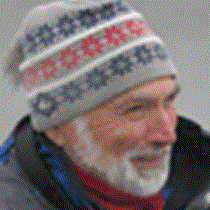Glacier Bay
For many of us, our first early morning views of Glacier Bay included two humpback whales as we left the park entrance at Bartlett Cove. Sunlight lit the distant mountains and small islands covered by glaciers only two hundred years before. Much of the bay has the feeling of raw landscapes only recently freed from the grip of ice. We had an early breakfast and were soon in the midst of birds calling and flying about South Marble Island. Our National Park Service Ranger, Mary Lou Blakeslee, was picked up when we first entered the park. She had earlier given us an excellent introduction to the birds we were now seeing. Tufted puffins looked out from near their burrows, while black-legged kittiwakes boiled off the cliffs at times or formed groups of hundreds upon the rocks. Fuzzy gray chicks from glaucous-winged gulls stared blankly at each other, and pelagic cormorants stood stoically amidst the fray.
Several hundred northern sea lions were hauled out on the island. A few are pictured above. These non-breeders were not able to hold territories on the breeding islands of the outer coast so were free to forage here. The western population of northern sea lions, also known as Steller sea lions, has had a food related population crash in recent years, but those in Southeast Alaska are increasing in numbers. Glacier Bay is a productive area that is home to other marine mammals as well. We were lucky enough to also see harbor seals, harbor porpoises, sea otters, and humpback whales.
During lunch, our ship cruised into Johns Hopkins Inlet. We were able to travel to the end of this beautiful fjord to within a quarter of a mile of the glacier. This “humongus” river of ice is 250’ high and over a mile wide at its face. Several times the bases of these walls crumbled and the ice they supported cascaded downward to soon erupt into an explosion of spray.
Later in the afternoon we explored Geike Inlet by ship and hiked an intriguing trail through a young forest at Bartlett Cove. Evening closed in and followed close behind us as we hiked out of the forest into the last light of day.
For many of us, our first early morning views of Glacier Bay included two humpback whales as we left the park entrance at Bartlett Cove. Sunlight lit the distant mountains and small islands covered by glaciers only two hundred years before. Much of the bay has the feeling of raw landscapes only recently freed from the grip of ice. We had an early breakfast and were soon in the midst of birds calling and flying about South Marble Island. Our National Park Service Ranger, Mary Lou Blakeslee, was picked up when we first entered the park. She had earlier given us an excellent introduction to the birds we were now seeing. Tufted puffins looked out from near their burrows, while black-legged kittiwakes boiled off the cliffs at times or formed groups of hundreds upon the rocks. Fuzzy gray chicks from glaucous-winged gulls stared blankly at each other, and pelagic cormorants stood stoically amidst the fray.
Several hundred northern sea lions were hauled out on the island. A few are pictured above. These non-breeders were not able to hold territories on the breeding islands of the outer coast so were free to forage here. The western population of northern sea lions, also known as Steller sea lions, has had a food related population crash in recent years, but those in Southeast Alaska are increasing in numbers. Glacier Bay is a productive area that is home to other marine mammals as well. We were lucky enough to also see harbor seals, harbor porpoises, sea otters, and humpback whales.
During lunch, our ship cruised into Johns Hopkins Inlet. We were able to travel to the end of this beautiful fjord to within a quarter of a mile of the glacier. This “humongus” river of ice is 250’ high and over a mile wide at its face. Several times the bases of these walls crumbled and the ice they supported cascaded downward to soon erupt into an explosion of spray.
Later in the afternoon we explored Geike Inlet by ship and hiked an intriguing trail through a young forest at Bartlett Cove. Evening closed in and followed close behind us as we hiked out of the forest into the last light of day.




